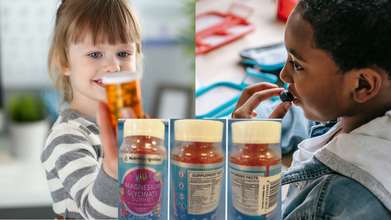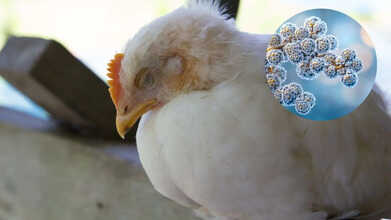- Health Conditions A-Z
- Health & Wellness
- Nutrition
- Fitness
- Health News
- Ayurveda
- Videos
- Medicine A-Z
- Parenting
- Web Stories
Stop All Use Of Magnesium Gummies For Kids - Says UK Government

Due to the massive popularity of magnesium and its potential health benefits, many parents had incorporated it into their kid’s consumption as well. However, the UK government has asked for parents and caregivers to immediately stop giving Nutrition Ignition Kids Magnesium Glycinate Gummies to children.
The Medicines and Healthcare products Regulatory Agency (MHRA) found an unlisted medicine, melatonin, in the product. It's important to safely throw away any gummies you have left and to talk to a doctor if you're worried about your child's health.
Why Do You Need To Stop Giving These Supplements?
The MHRA discovered that the gummies, sold online as a food supplement, contain melatonin, even though it is not on the label. Each gummy has 1.5 to 1.7 milligrams of melatonin. This is a lot, especially since the recommended starting dose for children who need melatonin is only 1 milligram. The gummies were marketed for "calm, focus, and digestion" for kids ages four and older, but they contain a powerful, unlisted drug.
What Are The Potential Side Effects of The Magnesium Supplements?
Taking too much melatonin can cause side effects like drowsiness, headaches, dizziness, and nausea. While these issues are not expected to cause lasting harm and the body typically clears the drug within 12 hours, the MHRA has already removed the product from online stores. Dr. Alison Cave, the MHRA's Chief Safety Officer, also pointed out that other possible side effects from melatonin in children can be hyperactivity and stomach pain.
What Is The Safest Way To Dispose The Supplements?
It is very important that you do not throw these gummies in the regular trash. Instead, you should store them securely in a container that children cannot open and keep them out of their reach. When you can, take the gummies to any local pharmacy for safe disposal. If you think your child had a bad reaction to the product, stop giving it to them right away and talk to a doctor. You can also report the side effect to the MHRA's Yellow Card scheme.
H5N1 Strikes Again: Poultry Farms Across the U.S. Affected

Credits: Canva
With Nebraska reporting its first case of highly pathogenic avian influenza (H5N1) in dairy cattle last month, officials in three Midwestern states have now confirmed new outbreaks of H5N1 in poultry on commercial farms. While not the first for these states, the latest detections highlight the ongoing presence of the virus. In Iowa, this marks the state’s eighth outbreak in domestic birds this year, and Minnesota has reported eight poultry outbreaks since mid-September.
H5N1 Strikes Poultry Farms Across US
The Iowa Department of Agriculture and Land Stewardship (IDALS) and the US Department of Agriculture (USDA) Animal and Plant Health Inspection Service (APHIS) confirmed the latest H5N1 case on October 2. Officials discovered the virus in a commercial turkey flock in west-central Iowa. Iowa’s previous poultry outbreak was recorded in April.
Minnesota reported two outbreaks on September 28 at commercial breeder poultry farms in Becker and Otter Tail Counties, which are adjacent to one another in the state’s west-central region. Together, the two farms house over 36,000 birds, according to the University of Minnesota.
Wisconsin followed with another confirmation on October 1 of H5N1 in a commercial flock in Jefferson County, located between Madison and Milwaukee. The Wisconsin Department of Agriculture, Trade and Consumer Protection (DATCP) issued guidance urging all livestock owners to strengthen biosecurity measures to prevent the virus from spreading to their animals.
What Is H5N1?
H5N1 is a highly pathogenic strain of avian influenza, commonly called bird flu, which primarily infects birds but can also spread to humans and other mammals through close contact with infected animals or contaminated environments. While human-to-human transmission is uncommon, the infection can be severe and has a high mortality rate. The virus has spread worldwide among wild birds and poultry and has recently been detected in mammals, including dairy cows. Health authorities recommend avoiding raw milk and taking protective measures when handling animals, according to the World Health Organization.
Can H5N1 Affect Humans?
Yes, H5N1 can infect humans, causing symptoms such as eye irritation, respiratory problems, and gastrointestinal issues. Although transmission between humans is rare, those who have direct contact with infected birds, mammals like dairy cows, or contaminated environments are at higher risk, per WHO guidelines.
How Humans Get Infected
- Contact with infected animals: Handling sick or deceased poultry, wild birds, or dairy cows can lead to infection.
- Contaminated surfaces: Touching surfaces contaminated with virus-containing fluids from infected birds or animals and then touching your eyes, nose, or mouth.
- Contaminated food: Consuming raw milk from infected cows or other foods contaminated with the live virus.
Is Bird Flu Contagious?
Bird flu rarely spreads from person to person. While a few cases of human-to-human transmission have been documented, none occurred in the U.S. Nearly all human infections so far have resulted from direct contact with infected animals. Still, any human infection carries a risk that the virus could mutate and spread more easily between people.
New Type Of Diabetes Poses Risk For Infants Under 6 Months; What Parents Need to Know

Credits: Canva
Advanced DNA sequencing and innovative stem cell research have allowed an international team of scientists to identify a new form of diabetes that affects infants. This rare type of diabetes can appear in babies under six months old, causing symptoms such as fatigue, poor weight gain, and excessive thirst. Using cutting-edge DNA sequencing and a novel stem cell model, researchers from the University of Exeter in the UK and Université Libre de Bruxelles (ULB) pinpointed mutations in the TMEM167A gene, which is linked to this uncommon form of neonatal diabetes. Let’s take a closer look at the study.
The Study and Its Findings
Published in the Journal of Clinical Investigation (JCI), the study involved researchers from the University of Exeter Medical School, ULB in Belgium, and other collaborators. They discovered that more than 85% of neonatal diabetes cases registered are associated with a genetic mutation. Advanced DNA sequencing and the new stem cell model enabled the team to identify alterations in the TMEM167A gene, which is responsible for this rare condition in infants.
Role of TMEM167A Gene
Investigating how this gene influences diabetes in babies under six months, Professor Miriam Cnop and her team at ULB found that when the TMEM167A gene is altered, insulin-producing cells fail to function properly. This triggers cellular stress mechanisms that can even lead to cell death.
“Identifying the DNA changes behind diabetes in infants gives us a unique window into the genes that are essential for insulin production and secretion. In this collaborative study, pinpointing specific DNA mutations in six children helped us uncover the role of the little-known TMEM167A gene, showing its crucial role in insulin secretion,” explained Dr. Elisa de Franco of the University of Exeter.
What Is Neonatal Diabetes?
Neonatal diabetes mellitus (NDM) is a rare form of diabetes caused by a single gene mutation, showing up within the first six months of a baby’s life. It leads to high blood sugar because the body doesn’t produce enough insulin. In some cases, the condition is permanent, lasting a lifetime, while in others, it may disappear during infancy but could return later in life.
Symptoms of Neonatal Diabetes
According to the Nationwide Children’s Hospital, infants under six months with neonatal diabetes may display symptoms such as dehydration, increased hunger, and frequent wet diapers.
How Common Is Neonatal Diabetes?
Neonatal diabetes is an extremely rare condition that appears in babies within the first six months of life. The National Institutes of Health (NIH) estimates it occurs in roughly 1 in every 90,000 to 400,000 births.
Neonatal Diabetes: What Parents Should Keep in Mind
Parents of infants diagnosed with neonatal diabetes should monitor their baby closely for signs of dehydration, unusual fatigue, or poor feeding. Regular medical check-ups and frequent blood sugar monitoring are crucial. It’s also important to maintain a consistent feeding schedule and follow the treatment plan prescribed by pediatric endocrinologists. Early intervention, careful observation, and support from healthcare providers can help manage symptoms and ensure healthier growth and development.
Two More Cough Syrups Banned After DEG Found In Them; Know Which Ones To Avoid

Credits: Canva
India Declares Three Cough Syrups ‘Toxic’ After DEG Contamination
While Coldrif was linked to all the child deaths, regulators in India, the world’s third-largest medicine producer have now advised consumers to avoid Respifresh TR and ReLife as well. None of these syrups have been exported, though the WHO warned of potential risks through unregulated channels.
Also Read: Cough Syrup Row: Death Toll Rise To 22 As 2 More Children Succumb
Details of the Three DEG-Contaminated Cough Syrups
Health alerts from Gujarat and other states describe both Respifresh and ReLife as containing DEG, “a toxic chemical that can cause serious poisoning, including kidney failure, neurological complications, and even death, particularly in children.”
COLDRIF
This syrup was linked to the deaths of children from Madhya Pradesh, who mostly died of kidney failure in government hospitals in other states. Produced by Sresan Pharmaceutical Manufacturer in Tamil Nadu, tests found it contained 48.6% diethylene glycol, far above the 0.1% limit set by India and WHO. The syrup has been banned, and the company owner has been arrested.
RESPIFRESH TR
So far, this syrup has not been linked to any deaths. It is manufactured by Rednex Pharmaceuticals in Gujarat and was found to contain 1.342% DEG, according to WHO reports. The syrup has been recalled, and the company has been ordered to halt production of all medical products.
RELIFE
Relife syrup also has not been connected to any deaths. Made by Shape Pharma in Gujarat in January 2025, with an expiry date of December 2026, it was found to contain 0.616% DEG. Like Respifresh, it has been recalled and production of all products by the company has been suspended.
WHO Calls Out Gap in India’s Cough Syrup Testing
In response to nationwide outrage over children’s deaths in Madhya Pradesh and Rajasthan, the WHO highlighted a “regulatory gap” in India regarding the testing for diethylene glycol and ethylene glycol in domestically marketed medicines. The agency also warned that such contaminated products could reach other countries through unregulated channels.
The WHO expressed deep sorrow over the deaths and extended condolences to the families. It said it had contacted the Central Drugs Standard Control Organisation (CDSCO) for clarification on the contaminated medicines and whether they had been exported. The CDSCO confirmed that DEG was detected in at least three cough syrups, Coldrif, Respifresh TR, and ReLife.
Coldrif Owner Arrested
The owner of Tamil Nadu-based Sresan Pharma, G Ranganathan, was arrested early Thursday morning in connection with the adulterated cough syrup case. The arrest followed the deaths of over 20 children from Madhya Pradesh who had consumed the contaminated syrup allegedly manufactured at the company’s facility. The Tamil Nadu government had previously sealed the factory after the incident came to light.
© 2024 Bennett, Coleman & Company Limited

